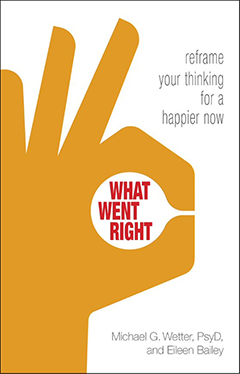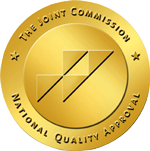
"Sometimes an accident is just an accident. Sometimes no one is to blame for bad things that happen."

Other titles you may like.

Earn it: What to do when your kid
needs an entitlement intervention

Addictive Personality: Understanding the Addictive
Process and Compulsive Behavior
Visit Recovery Road to view and
listen to all the episodes.
Episode 232 -- August 4, 2022
Six Tips for Avoiding Personalization and Blame
Guilt can be an emotion that's hard to balance. Some of us find ourselves feeling overwhelmed with guilt that isn't ours. Others always seem to put blame on someone else. Most of us do some of both. It's comforting to believe that there is someone at fault—even if it is us. We must learn the truth that there are some situations in life where no one is at fault; things just happen.
In their book What Went Right: Reframe Your Thinking for a Happier Now, Dr. Michael G. Wetter and Eileen Baley introduce easy-to-understand principles and techniques for recognizing and stopping self-defeating thought processes. This book can help us unlock self-affirming feelings and develop habits for healing and growing in our recovery.
The following excerpt describes the difference between personalization and blame, two unhealthy responses to guilt. It also offers tips on how to avoid these responses and improve our self-esteem. We can learn how to realistically look at situations and take responsibility for our actions without being too hard on ourselves. This gives us back the power to make positive changes in our lives.
This excerpt has been edited for brevity.
Personalization
Personalization occurs when you assume responsibility when things go wrong, even when they are out of your control. The following situations are good examples.
Gina's daughter brings home a failing grade, and Gina blames herself for being a bad mother instead of trying to find the cause of her child's struggle and helping her daughter better understand the material.
Kwan leaves his dog home alone; the dog knocks over his water bowl and then doesn't have anything to drink for several hours. Kwan sees himself as a terrible person instead of accepting that it's an accident.
Laura's boss is in a bad mood, and she assumes it's something she has done wrong instead of considering that perhaps he is having a fight with his wife, his boss isn't happy with the company's overall productivity, or he isn't feeling well.
Paul's partner leaves for work in the morning without giving him a kiss goodbye; Paul assumes he is angry with him rather than considering that his partner is distracted about what's going on at work.
When you personalize, you accept all of the responsibility for situations and see other people's reactions as a personal response to you. You don't look for alternative explanations. Personalization often leads to feelings of guilt, shame, and inadequacy.
Blaming yourself also works on the premise that someone must always be at fault. However, there are some situations in life where no one is at fault; misfortune just happens—as we see with Annie's experience.
Annie asks her son to walk to the store to buy milk. Teddy walks the two blocks to the store and buys the milk. When he is on his way home, it starts raining. By the time Teddy reaches the house, his clothes are soaked. Annie feels guilty and thinks she is a bad parent for causing her son to get wet—as if she is responsible for the rain.
These types of situations can make some people feel very helpless and powerless. It's comforting to believe that there is someone at fault or someone to blame, even if it is yourself. It gives you a feeling of control over your world. It means there is no randomness to life—someone is always in charge. The guilt of self-blame is easier to bear, in some cases, than feeling powerless.
Questions to Ask YourselfIf you find yourself feeling guilty about circumstances, ask yourself the following questions:
- Is this situation only about me?
- What evidence is there that I'm solely to blame?
- Did this occur because of something outside my control?
- What other explanations are there?
- What or who else is involved? Are they responsible or partially responsible for what happened?
- When I take away the guilt, can I find things or ways I can change to make things better?
Blame is intricately linked to low self-esteem. At first glance, it would seem that the opposite would be true. If you don't have to take any responsibility for problems, then you must feel good about yourself, right? Wrong! When you constantly blame others, you're inwardly telling yourself that you're incapable of handling or changing a situation. You make yourself a victim of circumstances or give in to other people's choices. That's not to say you should shoulder all the responsibility for everything (see the section on personalization earlier in this chapter). Instead, you should realistically look at a situation and determine which portion of blame belongs to you. You want to take responsibility for your actions without being unduly hard on yourself. This gives you back the power to make positive changes in your life. The following steps might help:
- Look for the cause of the problem. When a problem arises, you might immediately search for a reason or cause and look for who or what you can blame. Instead, try to be objective and find the actual cause, even if this means accepting the situation as is for a while until you can gather more information
- Accept that mistakes and missteps are a part of growing. Many of us are afraid to admit we made a mistake because we think it shows weakness, but the opposite is actually true. Admitting a mistake is a way for you to grow and learn to accept that you can be a flawed human being and still be a worthwhile person
- Focus on the solution rather than the problem. It might be easy to blame someone because it absolves you and eliminates your need to solve the problem. The best course of action is to accept your part in the situation and then focus on how to move forward.
- Accept that in some situations, no one is to blame. Sometimes an accident is just an accident. Sometimes no one is to blame for bad things that happen. Use the responsibility pie chart Challenge presented earlier in the chapter to decide whether anyone is to blame or if the misfortune is happenstance.
- Look at situations as a way to grow and learn rather than to blame or take responsibility. Sometimes you might make a mistake; sometimes other people will. Either way, the important takeaway is to learn from the situation.
- Try to treat others with respect. When you blame others, you might treat them poorly, berate them, or feel they should pay for their mistakes. People, you included, shouldn't be defined by a mistake. When you treat others respectfully, you'll usually be treated with respect in return, which will bolster your self-esteem.
- Accept that we live in a fallible and imperfect world. You can work to improve yourself, and you can work toward making this world a better place. But always keep in mind that it's an imperfect world; everyone in it will make mistakes. Holding people to high and impossible standards only causes you to remain disappointed and unhappy.
- When you notice yourself blaming others, take a step back and consider your part in the situation. This doesn't necessarily absolve everyone else, but it does mean you can look at your own thoughts, behaviors, and actions and decide if you played a part in the situation. If so, decide what you can do to change and what you can learn to further your personal growth.
- Let go of what went wrong. The more you focus on the problem, the less chance you have of finding a solution. Try to look at the situation objectively from a third-party perspective and come up with a solution.
About the Author:
Dr. Michael G. Wetter is a licensed clinical psychologist specializing in adolescent and adult populations. He has served on the faculty and staff of several leading national medical organizations including Kaiser Permanente, is on staff at Cedars-Sinai Medical Center, and is a subject matter expert for the California State Licensing Board of Psychology. Dr. Wetter is a nationally recognized expert in the field of psychology and is a guest lecturer, training other psychologists and mental health professionals. Dr. Wetter has served as an expert consultant on numerous television programs, as well as to newspapers such as The Washington Post, Boston Globe, and Atlanta Journal-Constitution, and to magazines like Men's Health, Forbes, Prevention, and Redbook.
Eileen Bailey is a freelance writer specializing in mental and emotional health issues. She writes for numerous health and wellness websites and is lead writer for both ADHD and anxiety on HealthCentral.com as well as a contributing writer for ADDitude magazine online (www.additudemag.com). She is the co-author of The Complete Idiot's Guide to Adult ADHD, Idiot's Guides: Cognitive Behavioral Therapy, The Essential Guide to Overcoming Obsessive Love, and The Essential Guide to Asperger's Syndrome.
© 2016 by Michael G. Wetter and Eileen Bailey
All rights reserved


